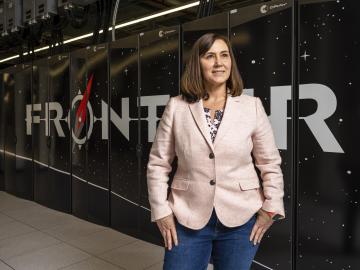
Filter News
Area of Research
- (-) Neutron Science (6)
- (-) Supercomputing (37)
- Biological Systems (1)
- Biology and Environment (32)
- Electricity and Smart Grid (1)
- Energy Science (24)
- Fusion and Fission (2)
- Isotopes (17)
- Materials (16)
- Materials for Computing (3)
- National Security (6)
- Nuclear Science and Technology (2)
- Quantum information Science (4)
News Topics
- (-) Bioenergy (6)
- (-) Frontier (17)
- (-) Grid (1)
- (-) Isotopes (1)
- (-) Microscopy (2)
- (-) Quantum Computing (11)
- (-) Quantum Science (11)
- (-) Space Exploration (2)
- 3-D Printing/Advanced Manufacturing (4)
- Artificial Intelligence (23)
- Big Data (16)
- Biology (8)
- Biomedical (13)
- Biotechnology (1)
- Buildings (2)
- Chemical Sciences (2)
- Clean Water (2)
- Computer Science (48)
- Coronavirus (9)
- Cybersecurity (2)
- Energy Storage (3)
- Environment (17)
- Exascale Computing (16)
- Fossil Energy (1)
- High-Performance Computing (25)
- Hydropower (1)
- Machine Learning (10)
- Materials (9)
- Materials Science (13)
- Mathematics (2)
- Nanotechnology (6)
- National Security (3)
- Neutron Science (56)
- Nuclear Energy (3)
- Physics (5)
- Polymers (1)
- Security (3)
- Simulation (12)
- Software (1)
- Summit (22)
- Transportation (4)
Media Contacts

Outside the high-performance computing, or HPC, community, exascale may seem more like fodder for science fiction than a powerful tool for scientific research. Yet, when seen through the lens of real-world applications, exascale computing goes from ethereal concept to tangible reality with exceptional benefits.

Quantum computing sits on the cutting edge of scientific discovery. Given its novelty, the next generation of researchers will contribute significantly to the advancement of the field. However, this new crop of scientists must first be cultivated.

Wildfires have shaped the environment for millennia, but they are increasing in frequency, range and intensity in response to a hotter climate. The phenomenon is being incorporated into high-resolution simulations of the Earth’s climate by scientists at the Department of Energy’s Oak Ridge National Laboratory, with a mission to better understand and predict environmental change.

With the world’s first exascale supercomputer now fully open for scientific business, researchers can thank the early users who helped get the machine up to speed.

To support the development of a revolutionary new open fan engine architecture for the future of flight, GE Aerospace has run simulations using the world’s fastest supercomputer capable of crunching data in excess of exascale speed, or more than a quintillion calculations per second.

In late May, the Quantum Science Center convened its first in-person all-hands meeting since the center was established in 2020. More than 120 QSC members gathered in Nashville, Tennessee to discuss the center’s operations, research and overarching scientific aims.
For the third year in a row, the Quantum Science Center held its signature workforce development event: a comprehensive summer school for students and early-career scientists designed to facilitate conversations and hands-on activities related to

At the National Center for Computational Sciences, Ashley Barker enjoys one of the least complicated–sounding job titles at ORNL: section head of operations. But within that seemingly ordinary designation lurks a multitude of demanding roles as she oversees the complete user experience for NCCS computer systems.

Researchers used Oak Ridge National Laboratory’s Quantum Computing User Program to perform the first independent comparison test of leading quantum computers.

A trio of new and improved cosmological simulation codes was unveiled in a series of presentations at the annual April Meeting of the American Physical Society in Minneapolis.


